Despite wide-ranging concerns relating to genetically modified foods and crops, the use of GMOs in farming has increased annually since the technology’s commercial introduction in 1996. According to the ISAAA, an international organization that supports crop biotechnology, biotech crops have increased 100-fold, from 1.7 million hectares (4.2 million acres) in 1996, to 170 million hectares (420 million acres) in 2012. These 170 million hectares mean that GMO crops now occupy over 10% of the world’s arable land. 1 While these statistics show how widespread GMO crop usage has become and how lucrative GMO seeds have been for the biotech industry over these last 17 years, it is important to note that with the growth of GMO use there still has not been a clear reflection of improvements for crop yields or for benefits for the welfare of the actual farmers growing GMOs. Figure 1.
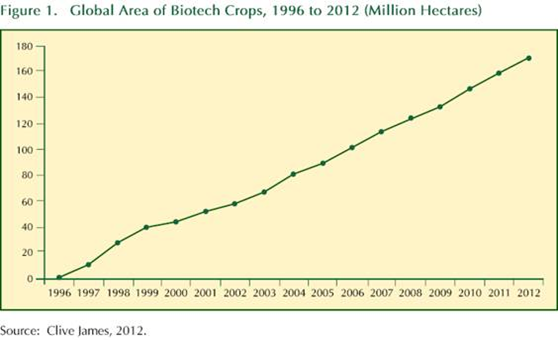
In 2012, 17.3 million farmers grew GMO crops 1, and 9 countries grow 97% of world’s GM crops. Together, the US, Brazil, Argentina grow 76.3% of the world’s GM crops 2. A graphic from Mother Jones shows these ISAA statistics: Figure 2.
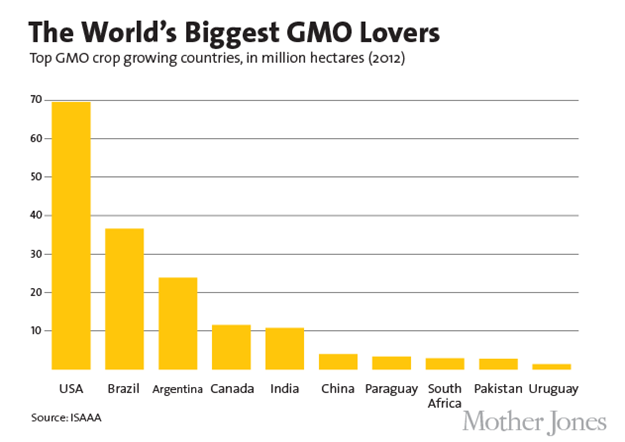
Worldwide, 8 GMO crops have been approved for commercial production; soy, cotton, corn, canola, sugarbeet, papaya, squash or yellow zucchini, and alfalfa, and the biotech industry is in the process of pushing forward additionally modified foods such as rice, apples, and salmon. The four major crops that account for virtually all of the biotech output are soy, cotton, corn, and canola. The remaining GMO crops are exclusively grown in the United States with the exception being papaya which is grown in China in addition to US cultivation. Figure 3.
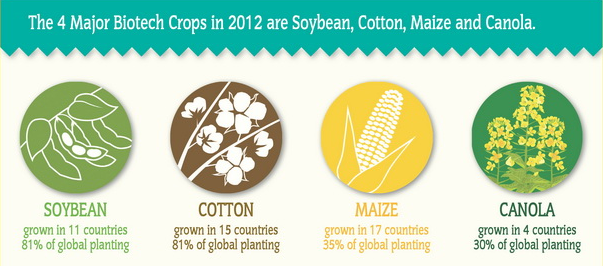
Figure 3 shows the pervasiveness of GMOs in global crops; but in the United States, where every possible approved commercial GM crop is grown, the numbers are even more striking. Recent statistics show that GM varieties account for approximately:
- 94% of US soy crops (which by volume accounts for just under half of all the GM crops grown worldwide)
- 94% of US cotton plantings
- 92% of the US corn crop
- 94% of the US canola crop
- 98.5% of US sugar beet plantings
- Alfalfa (first planted in 2011)
- Papaya (most of Hawaiian crop; approximately 988 acres)
- Zucchini, yellow summer squash (approximately 25,000 acres)
Figure 4.
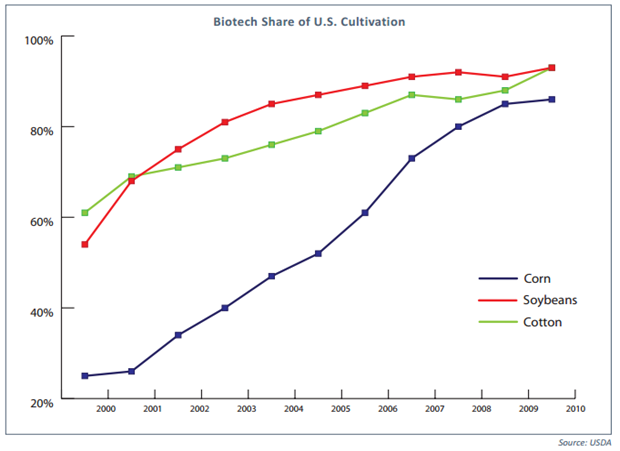
Where do these GMOs go? While supporters of GMO crops argue that GMOs are essential to feeding a growing world population, the truth is that in the United States (the world’s foremost GMO producer and consumer) and in other major GMO producing countries, an overwhelming majority of the GMO crop is not even consumed directly by humans. In the US, livestock has been fed genetically engineered crops since these crops were first introduced in 1996 and each of the top 6 GMO crops (soy, cotton, corn, canola, sugar beet, and alfalfa) are heavily utilized by the US and global animal feed market. The US, Brazil, China are world leaders of commercially produced animal feed--and these countries are also some of the largest producers of GMO crops (see Figure 2). Public consciousness for the pervasiveness of GMOs in the feed of the animals that produce our eggs, meat, and dairy is extremely low, but it is no coincidence that the largest animal feed producing countries in the world are also the largest producers and consumers of GMOs. Commercial animal feed is composed directly from harvest crops and the leftovers of processed crops. Some of the most common commodity feed ingredients are soy, cotton, corn, canola, sugar beets, and alfalfa. Seeing that the countries that produce the most animal feed--the United States, Brazil, and China--are all leaders in GMO production, it is very clear that their animal feed products are consequently composed of significant amounts of GMOs.
- The commercial animal feed industry is by far the largest purchaser of US corn and soybean meal; the majority of these US crops are genetically modified: corn 88% and soybeans 94%.
- Of the two largest GMO crops in the United States, 98% soy and 79.5% of corn goes directly into feeding animals and fueling cars in the US. 34
Taking a Look at Common Commodity Feed Ingredients: Soy
- Soybean meal is the largest protein meal produced in the world; GMO soybeans are widespread in the main soybean producing countries
- 90% of the world’s soy is used to feed animals 5
- 98% of the soy in the US goes into livestock feeding and car fuel production, with by-products of this used for food ingredients such as lecithin and oils 3
Figure 6.
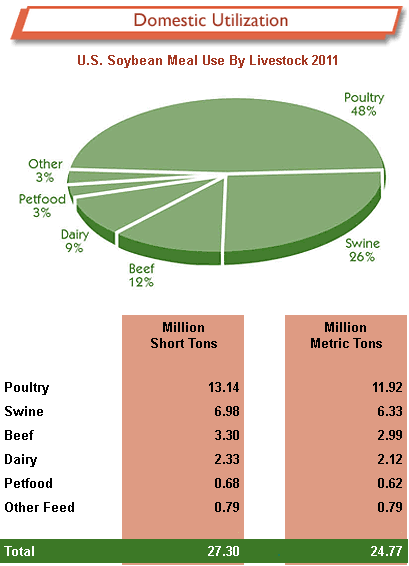
- 94% of the US soy crop is genetically modified
Cotton
- Cotton is used for more than textiles. It is also an ingredient in animal feed and for various processed foods. 6
- The United States, China, and India together provide two-thirds of the world's cotton. These are also the three countries with the largest percentages of pervasiveness for GMO in their cotton crop production
- The United States, which ranks third in production behind China and India, is the leading exporter, accounting for over one-third of global trade in raw cotton. 7

- 90% of the US cotton crop is genetically modified
Corn
- Corn is a major feedstuff ingredient, particularly in developed countries. Dairy cows, beef cattle, pigs, sheep, goats, poultry, and fish, and rabbits are fed corn in the US 8
- 32% of the world’s corn supply is grown in the United States. The US is the largest producer of corn.
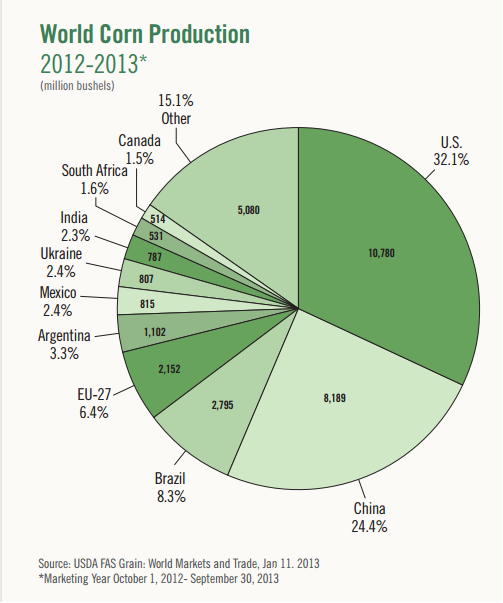
- According to the National Corn Growers Association, now about eighty percent of all corn grown in the US is consumed by domestic and overseas livestock, poultry, fish, and fuel production. 4
- 88% of the US corn crop is genetically modified.
Canola
- Canola meal is one of the most widely used protein sources in animal feed for livestock, poultry, and fish. 9
- Approximately 43% of a canola seed is oil. What remains is a canola meal that is used as an ingredient in animal feed. 10
- Canada, the largest single country producer of Canola, exports 85% of their canola.11 According to the ISAAA, 97.5% of the canola grown in Canada last year was genetically modified. The biggest buyer of canola oil and meal for animal feed is the United States.
- The United States also produces its own canola in states adjacent to Canada - North Dakota, Montana and Minnesota produce over 90 percent of the nation's canola crop.12
- 90% of the US canola crop is genetically modified.
Sugar Beet
- Sugar Beet Pulp – Sugar beets are processed so that the sugar stored in the beet root is separated from the rest of the plant material. The sugar beets are boiled in water and the resulting sugar-containing juice is filtered, concentrated into a thick syrup, and then washed in a spinning centrifuge to separate sugar, molasses, and dried beet pulp. After sugar and molasses have been recovered from the sugar beet, the remaining pulp is utilized for animal feed.
- 57% of American sugar production comes from sugar beets, the rest from sugar cane. 13
- 95% of the US sugar beet crop is genetically modified.
Alfalfa
- Dairy cows are the primary consumers of alfalfa hay .
- GM-alfalfa was first approved in 2011.
Feed Market The American commodity feed industry heavily impacts the global market. The US accounts for 22% of global output according to the International Feed Industry Federation 14. Other major GMO producing countries in South America and Asia are also accountable for large contributions to commercial animal feed production. Figure 9.
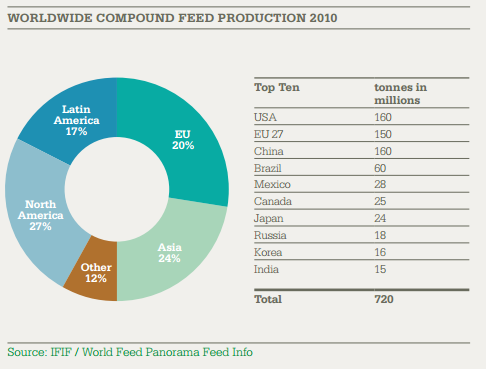
In the United States, unlike most other developed countries, there are no specific regulations for foods or products manufactured using GMOs. While GMO labeling is required in 64 countries to various degrees (more here) around the world – only a few countries, like Brazil, Venezuela, and members of the EU also require labels for animal feed that contain GMOs. Brazil is an important country to note, because even though this country is one of the strongest supporters and producers of GMOs, they still allow their citizens to make informed decisions by labeling their animal feed if it contains GMOs. For livestock farmers in the US this remains a mystery, but if the animal feed is not organic or non-GMO verified, it almost certainly contains GMOs. However, many countries that have food labeling laws do not have labeling requirements for animal feed, or for animal products produced from animals fed GMO crops. This loophole, where the GMO label is not applied to food products made from animals raised on GMOs, is responsible for a large amount of unnoticed GMO consumption. This loophole and other laws that allow GMOs to be a hidden part of the food system, mean that products like meat, eggs, and milk that were produced by animals consuming GMOs are able to enter the marketplace free of any GMO labeling. The United States of course, infamous for the pervasiveness of GMOs and the country’s lack of labeling laws, does not have to deal with the particular complexities of GMO animal feed labeling. In the United States, in order to avoid animal products that have not been influenced by GMO animal feed, consumers have to look for certified organic products (since organic standards prohibit the intentional use of GMOs) and for the recently release Non-GMO Project certification for meat, egg, and dairy products. The pervasiveness of GMOs in animal feed, also makes it a challenge for organic producers to secure uncontaminated organic feed. This is a challenge that will continue to grow if GMO crops are allowed to continue their land cover growth as a result of limited supply, increasing the risk of irreversible cross-contamination. Without clear labeling laws, consumers are being deceived into thinking they are not contributing to the consumption and production of GMOs. However, the statistics show that GMOs are hidden in our everyday foods and consumed by the animals that produce the meat, eggs, and dairy products that Americans consume in vast quantities.
___________________________________________________
Take action today by calling on #1 US yogurt brand Chobani… Chobani is the United States’ top Greek yogurt brand and it prides itself on adding no GMO ingredients to its yogurt. However, it is likely that the company is relying on milk from cows eating a diet of genetically modified organisms. GMO Inside, a national coalition led by Green America, is calling on Chobani to cease marketing its products as “real” and “natural” until the company switches to verified non-GMO milk sources. Tell Chobani to shift to non-GMO feed for their cows, to help accelerate the shift to a non-GMO food system! We and the cows thank you.
___________________________________________________
Resources 1 http://www.isaaa.org/resources/publications/briefs/44/executivesummary/default.asp 2 http://www.cban.ca/Press/Press-Releases/Global-Growth-of-GM-Crops-Overblown-ISAAA-yearly-report-misleads-says-CBAN 3 http://inspiredeconomist.com/2013/02/26/economic-argument-against-gmo/ 4 http://www.ncga.com/upload/files/documents/pdf/WOC%202013.pdf 5 Brown, L., 1999. The United States and China, the Soybean Connection. Worldwatch Institute, November 9, 1999. 6 http://www.gmo-compass.org/eng/grocery_shopping/crops/161.genetically_modified_cotton.html 7. http://www.ers.usda.gov/topics/crops/cotton-wool.aspx#.UeJy49I3uCc 8. http://www.feedipedia.org/node/71 9. http://www.uscanola.com/site/epage/102391_956.htm 10. http://canolacouncil.org/media/503589/canola_guide_english_2009_small.pdf 11. http://www.canolacouncil.org/markets-stats/markets/ 12. http://www.agmrc.org/commodities__products/grains__oilseeds/canola-profile/ 13. http://www.sugaralliance.org/more-sugar-facts. 14. http://www.ifif.org/uploadImage/2012/1/4/f41c7f95817b4c99782bef7abe8082dd1325696464.pdf


